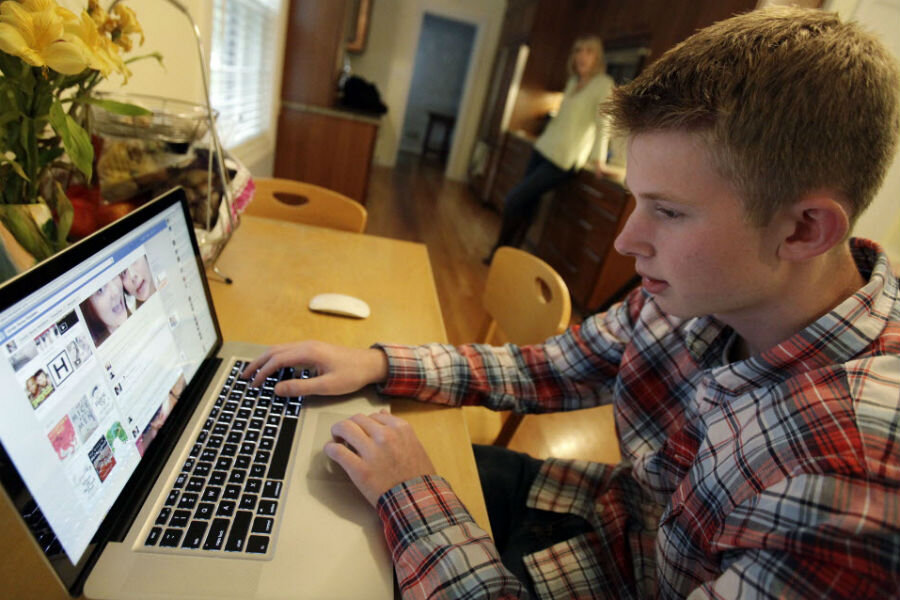Many teens have trouble spotting fake news, but it's not as bad as it sounds
Loading...
A study by researchers at Stanford University suggests that while teenagers have a knack for interpreting their friends' tweets and Instagram photos, they may not be as skilled when it comes to analyzing the news.
Eighty-two percent of middle school students surveyed couldn't tell the difference between an ad labeled "sponsored content" and a legitimate news story, according to the study. Additionally, many teens judged the credibility of news-related tweets based on how much detail the tweet contained or whether it included a photo, rather than on the source of the post.
In the midst of a nationwide debate over the proliferation of fake news on social media sites – and, as one 2015 study by the Media Insight Project shows, at a time when nearly 9 in 10 Millennials regularly get news from Facebook – the numbers, at first glance, may point to a bleak, uninformed future.
Indeed, the internet's vast wealth of news sources, many unreliable, has created new challenges for educators teaching students how to find credible information online, media literacy experts say. But there's also optimism among some that the adolescents growing up on social networks, surrounded by fake news sites, blogs, and clickbait articles, will turn into a more media-savvy generation of adults than exists today.
"There's an overall lack of cynicism on the part of teenagers, and a lack of awareness of a lot of the corruption and bad things that go on the world, and that's normal," says Jennifer Golbeck, an associate professor of information studies at the University of Maryland, College Park, in a phone interview with The Christian Science Monitor.
"But," she continues, "I think once these teens grow up and get older, they're actually going to have a much better insight into what it means to have things published online than their adult counterparts do now."
For older generations who grew up with "traditional journalism," Professor Golbreck explains, "these fake news sites look reliable." But younger generations more familiar with internet technology "don't have this feeling that it’s hard to get published or put online."
For an increasing number of students, that familiarity is accompanied by an education in "media literacy," or the ability to determine the legitimacy and motivations of a source of information.
As more and more people turn to online news sources and social media to learn about the world around them, many educators are adjusting the way they teach research skills accordingly. A growing number of schools are helping their students to cultivate a stronger sense of media literacy, aided by educational organizations offering lesson plans and teaching tools.
One such initiative, the University of Rhode Island's Media Education Lab, offers a number of free resources for K-12 media literacy education, including a comprehensive three-volume curriculum, a series of videos designed to promote critical thinking about the media, and a crowdsourced gallery of more than 600 examples of contemporary propaganda from the internet, mass media, and social media.
"[T]he surfeit of information available to people through the Internet ... creates new challenges in terms of evaluating and assessing it," writes Renee Hobbs, founder and director of the Media Education Lab, in an email to the Monitor. The fact that people tend to blindly trust news shared by their friends on social media, she adds, doesn't help.
The Stanford University study found 82 percent of middle-schoolers unable to distinguish between an ad labeled "sponsored content" and a real news story on a website, and more than 2 out of 3 middle-schoolers couldn’t see any reason to mistrust a post written by a bank executive, arguing that young adults need more financial-planning help, The Wall Street Journal reports.
But with the proper tools, Professor Hobbs says, "teachers and students can learn to distinguish harmful from beneficial propaganda and recognize techniques designed to evoke strong emotions, attack opponents, simplify information and appeal to audience fears, hopes, and dreams."
As buzz over the danger of biased or just plain fake news grows, many educators have taken it upon themselves to come up with their own lessons and projects. Melissa Zimdars, an assistant professor of communication at Merrimack College in North Andover, Mass., composed a list of "False, Misleading, Clickbait-y, and Satirical ‘News' Sources" for her students in a Google Doc that went viral.
The list was widely shared in the wake of Donald Trump's election victory, amid speculation that illegitimate and biased news shared on Facebook had influenced the election. But the original impetus for creating the list, Professor Zimdars told Pacific Standard, was a longtime concern regarding the sources her students were using in assignments or referencing in talking points.
Arming students with the proper skills to interpret and analyze what they find online doesn't just provide them with a sense of enlightenment, media literacy educators say – it can also hold news sources accountable for their content and heighten the level of national discourse.
"There’s a lesson here for all of us who worry about the quality of journalism today: Citizens armed with the power of discernment will do more to rescue journalism than any dozen panels of veteran editors ruminating about their golden years in power and musing about better business models," wrote Dean Miller, former director of the Center for News Literacy at Stony Brook University in New York, in a 2010 op-ed for the Monitor.
"Once students learn to seek truth instead of accept truth," he added, "they are well on their way to the kind of power the Founders abundantly reserved for American citizens."






